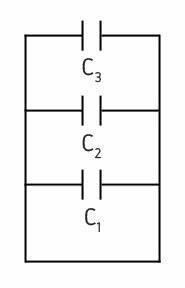The association of capacitors has the function of storing electrical energy to be used for a specific purpose. It can happen in three ways: in series, parallel and mixed.
Association of Serial Capacitors
In the association of capacitors in series, the plates that make up the capacitors are connected together as follows:
The negative plate of the capacitor connects to the positive plate of another capacitor, and so on.

This makes all capacitors have the same association charge, ie, Q = constant.
Through the following formula it is possible to determine the capacitance of the association of capacitors in series:
1/Ceq = 1/C1 +1/C2 +1/C3 +... 1/Cno
Association of Parallel Capacitors
In the association of capacitors in parallel, the negative plates of the capacitors are linked together.
Likewise, the positive plates are also connected to each other. That's why this type of association is called parallel association.

In this case, all capacitors have the same ddp (electric potential difference), that is, V = constant.
To calculate the association of capacitors in parallel, we add their capacitance using the formula:
Çeq = C1 + C2 +... Çno
Mixed Capacitors Association
In the mixed capacitor association, capacitors connected in series or in parallel are found.

For this reason, the calculation of the mixed capacitor association must be done in parts. First, calculate the capacitance of the association in parallel.
After obtaining this value, the capacitance of the series association is calculated.
read Capacitors and Physics Formulas.
Solved Exercises
1. (PUC-RS) A device commonly used in electrical circuits is called a capacitor, whose symbol is

The capacitance (C) of a capacitor is calculated through the ratio between the charge (Q) it stores in one of its armatures and the voltage (V) applied to it, that is, C = Q / V.
A capacitor A, with AC capacitance, is initially subjected to a voltage V. Then, another capacitor, B, with a different capacitance CB, is connected in parallel with A, maintaining the same electrical voltage V in the association.
Regarding the association of capacitors, A and B, it can be said that
a) after being associated, the capacitors will have equal charges.
b) the energy of the association is equal to the initial energy of A.
c) the energy of the association is less than the initial energy of A.
d) after associating, the capacitor with the lowest capacitance will have the highest charge.
e) the capacitance of the association is equal to the sum of the capacitances of A and B.
Alternative e: the capacitance of the association is equal to the sum of the capacitances of A and B.
2. (FUNREI 2000) Given three capacitors, each as a capacitance c, which capacitance equivalent to an association between them is incorrect?
a) w/3
b) 3c
c) 2c/3
d) 3c/2
Alternative c: 2c/3

